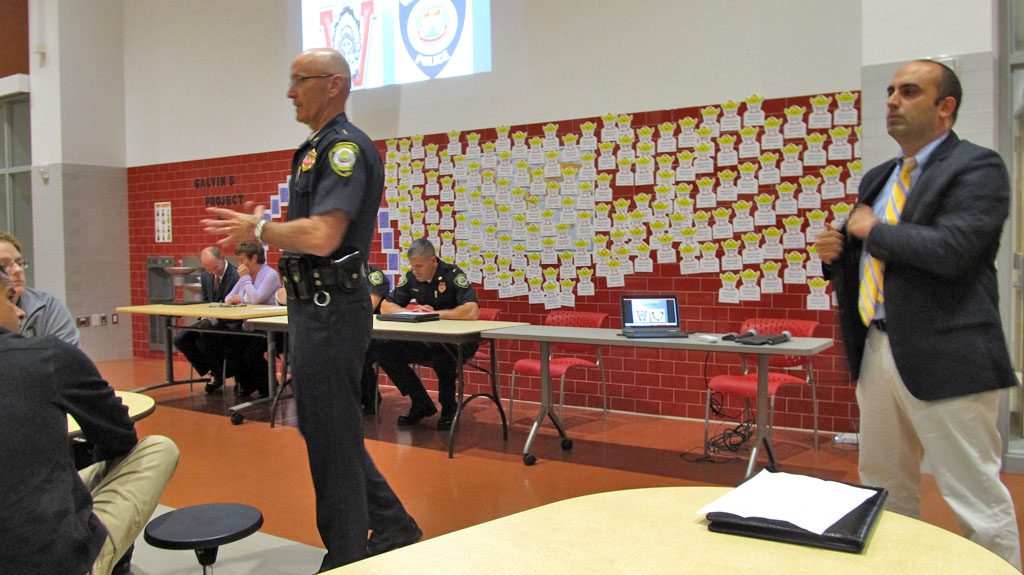By GAIL LOWE

WAKEFIELD’S CHIEF OF POLICE Rick Smith and Superintendent of Schools Dr. Stephen K. Zrike spoke last Thursday night to parents about A.L.I.C.E., a new approach to lockdown at schools in the event of an intruder with the intent to do harm to faculty and students. The talk was held at the new Galvin Middle School. (Gail Lowe Photo)
WAKEFIELD — It’s a subject no one wants to talk about but talk about it everyone must to keep the town’s schools safe from intruders intent on destroying human life.
This past Thursday night, about 60 parents attended an info-share event concerning A.L.I.C.E., a lockdown initiative, in the event of a catastrophic incident similar to the one that took place at Sandy Hook Elementary School in Newtown, Conn. on Dec. 14, 2012 where 28 people were killed, including the shooter and his mother.
The initial caps in A.L.I.C.E. stand for “alert,” “lockdown,” “inform,” “counter” and “evacuate.”
“The A.L.I.C.E. approach is the best way to protect our children from an active shooter,” said Wakefield Police Chief Rick Smith at the event. “We want to be in front of it. We are in front of it.”
Smith said that his department, along with the School Department, has been working to implement A.L.I.C.E. in a way that school staff, faculty and students can make informed decisions in a crisis, remove as many people as possible from a dangerous situation and provide training so that those involved in a crisis have a better chance of surviving.
Chief Smith noted that A.L.I.C.E. does not replace the current lockdown procedure. It only enhances what is currently in place.
During the “counter” phase, staff and students are not encouraged to fight the intruder but are shown distraction and survival techniques that can be used if confronted by a threat.
The A.L.I.C.E plan will be implemented throughout the schools in phases. The first student training is scheduled to be completed before the end of 2014 calendar year.
“Based on all local and national recommendations that have come out over recent times, we feel strongly that this is the best program to maintain student and faculty safety if faced with this type of incident,” said Superintendent of Schools Dr. Stephen K. Zrike. He acknowledged that he is not an expert on A.L.I.C.E. and, in fact, had never heard of it until Chief Smith brought it to his attention.
“There’s no money to be invested — it’s not really a program. It’s an approach. It’s about empowering teachers,” said Zrike, “and it makes sense.”
Zrike explained that a district crisis team was launched last December when members of the school, town and clergy met to discuss the plan in place to thwart an intruder. What was learned through the discovery process was that Wakefield’s lockdown procedures were “inappropriate and outdated,” he said.
Soon after school opened in September, all School Department members were introduced to A.L.I.C.E.
Dr. Zrike said there was a “slow start to get it right.”
“The message to students depends on their age level,” he said. “We’ve pledged to partner with the Police Department. We can never be too cautious.”
Wakefield Police Lt. Craig Calabrese also was at the meeting, along with high school Guidance Counselor Brian Robertson, and showed slides that further explained A.L.I.C.E. For example, the approach is not a complete procedure but general recommendations fitting each building and grade level.
“There was 16 hours of training over two days, and it integrates technology with common sense and human action,” said Calabrese, adding that A.L.I.C.E. is in alignment with the Department of Homeland Security and guidelines established by the governor’s office.
Specific reference was made to the attack at Virginia Tech in April 2007, which resulted in 28 fatalities. Some students barricaded doors while others jumped out of windows.
Calabrese pointed out that schools are often targets due to the potential for mass casualties and the high profile a shooter would gain as a result of such a crime.
He suggested using plain language instead of codes and said that simple items like door wedges, desks and tables can be used to barricade doors.
Students in grades 5 through 12 will receive the most training while children in the lower grades ail receive less. They will be taught that staplers, books and even chairs can be used as weapons.
“We will teach distraction techniques but not below grade 5,” said Calabrese, “including throwing cell phones and creating chaos. Children will be taught to run in a zig-zag pattern.”
Therese Jarmusik, assistant principal of the Galvin Middle School, followed Calabrese’s presentation and said that three faculty members from the high school, middle school and elementary school received training in May and had follow-up sessions over the summer.
“There was a simulation with a pellet gun and it was scary,” she said.
Implementation at the high school will be completed by the end of December 2014, the middle school the end of the the 2014-2015 school year and the elementary school will be held during the 2015-2016 school year.
Parents, she said, would be notified before the trainings.
Lockdown practice at the high school was handled in September and the Police Department trained faculty members on Oct. 6.
A question and answer session followed the presentation when parents asked about the method of communication in schools other than the Galvin Middle School, which has state-of-the-art mechanisms in place for communicating throughout the school. Other areas addressed included established meeting places outside the schools and what parents should do if they learn their children are vulnerable to attack.
Where students should go in the event of an evacuation has been mapped out, and one place is the hall at the St. Joseph Church on Albion Street.
Messages to the community would be sent out once students were evacuated.
Dr. Zrike said that he is a “fanatic” when it comes to keeping school doors locked and asked that an e-mail be sent to him if anyone finds a door propped open or is simply found left open.
Asked about a gunman encountering students and faculty in a hallway, it was suggested that students get inside a closet, remain in a bathroom or get out of the school.
One parent asked about what would happen if a child suffers from diabetes and needs insulin while in hiding. Jarmusik said sweets and snacks are kept on hand in the event they are needed.
Another parent asked about doors that push out rather than pull in to open.
“Wrap a belt or cord around the handle and use body weight to keep them closed,” said Zrike.
About A.L.I.C.E. Zrike said his department is “excited about its implementation as a critical school safety approach.”
“It’s an approach that empowers teachers and families to make life-saving decisions in the event of the unthinkable,” Zrike said. “I was pleased to see so many parents in attendance with important questions about the initiative and about our efforts to keep all students safe in our schools.”
Chief Smith agreed and added: “This is all good. The Police and School departments did a lot of work on A.L.I.C.E., including School Resource Officer Kelley Tobyne.
“The A.L.I.C.E. approach is second to none for school safety,” he said. “To quote Dr. Zrike, ‘It’s all about the children’ and the best way to protect them through a partnership between the School Department and Police Department. I want to commend all the stakeholders from Officer Tobyne, members of the Police and School departments for their commitment to make A.L.I.C.E. a big part of our school safety initiative.”




